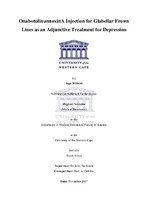| dc.description.abstract | Depression is one of the most prevalent mental disorders worldwide. Sadness, fear and anger which are considered as negative emotions and are common in depression are coupled with the stimulation of the Corrugator supercilli and procerus muscles in the glabellar area of the face. It has been suggested that OnabotulinumtoxinA (Botox) administered into brow muscles to treat glabellar frown lines may improve emotional states. This study aimed to investigate the effectiveness of Botox injection for glabellar frown lines as an adjunctive treatment for Major Depressive Disorder. The objective was also to determine whether Botox injections administered in glabellar frown lines improve quality of life and self-esteem. Twenty seven (27) participants diagnosed with major depressive disorder were randomly assigned to either the treatment group (Botox, n = 12), placebo group (saline, n = 8) and the control group (n = 7). Participants in the treatment group or placebo group were injected with Botox or saline solution in their procerus and Corrugator supercilli muscles at baseline and at week 12. The control group received no intervention and were only assessed at baseline and at the end of the 24 week period. To evaluate the effect of Botox treatment in the glabellar region on depressive symptoms the Montgomery-Asberg Depression Rating Scale (MADRS) and the Beck Depression Inventory (BDI) was used. The Quality of Life Enjoyment and Satisfaction Questionnaire-Short Form (Q-LES-Q-SF) and Rosenberg Self-Esteem Scale (RSES) was used in the assessment of quality of life and self-esteem respectively. Participants were assessed 3 weeks, 6 weeks, 12 weeks, and 24 weeks after baseline. In the present study, it was observed that repeated treatments (i.e. two treatments) of Botox in the glabellar region reduces the symptoms of depression. This effect was observed at the third week and continued until the end of the 24 week follow up period. An 82% vs 21.5% reduction in MADRS scores was observed for the Botox and placebo group respectively, and only a 16.4% reduction in MADRS scores for the control group. Statistical significant differences (p= 0.001) in MADRS response rates for the treatment groups were observed at week 24. The remission rate at week 24 were 83.3% for the Botox group. The placebo group had an equal percentage of remission (37.5%) and non-response (37.5%) rates at week 24. It was observed, as depression symptoms improved, there was a simultaneous improvement in quality of life in the experimental group. | |

